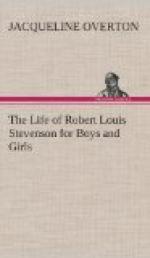He finished “Treasure Island,” the book that gained him his first popularity, and wrote “Dr. Jekyll and Mr. Hyde,” which made him famous at home and abroad.
“Treasure Island” had been started some time previous to please Lloyd, who asked him to write a “good story.” It all began with a map. Stevenson always loved maps, and one day during a picture-making bout he had drawn a fine one. “It was elaborately and (I thought) beautifully colored,” he says. “The shape of it took my fancy beyond expression; it contained harbors that pleased me like sonnets.... I ticketed my performance Treasure Island.”
Immediately the island began to take life and swarm with people, all sorts of strange scenes began to take place upon it, and as he gazed at his map Stevenson discovered the plot for the “good story.”
“It is horrid fun,” he wrote, “and begins in the Admiral Benbow public house on the Devon coast; all about a map and a treasure and a mutiny, and a derelict ship ... and a doctor and a sea-cook with one leg with the chorus ‘yo-ho-ho and a bottle of rum,’ ... No women in the story, Lloyd orders.”
Parts of the coast at Monterey flashed back to his mind and helped him to picture the scenery of his “Treasure Island.” “It was just such a place as the Monterey sand hills the hero John Hawkins found himself on leaving his mutinous shipmates. It was just such a thicket of live oak growing low along the sand like brambles, that he crawled and dodged when he heard the voices of the pirates near him and saw Long John Silver strike down with his crutch one of his mates who had refused to join in his plan for murder.”
[Illustration: The Treasure Island map]
As the story grew he read each new chapter aloud to the family in the evening. He was writing it for one boy, but found he had more in his audience. “My father,” he says, “not only heard with delight the daily chapter, but set himself actively to collaborate. When the time came for Billy Bones’ chest to be ransacked, he must have passed the better part of a day preparing on the back of a legal envelope an inventory of its contents, which I exactly followed, and the name of Flint’s old ship, the Walrus, was given at his particular request.”
When the map was redrawn for the book it was embellished with “blowing whales and sailing ships; and my father himself brought into service a knack he had of various writing, and elaborately forged the signature of Captain Flint and the sailing directions of Billy Bones.”
These daily readings were rare treats to those at Skerryvore, for Stevenson was a most dramatic reader. “When he came to stand in the place of Silver you could almost have imagined you saw the great one-legged John Silver, joyous-eyed, on the rolling sea.”
The book was not long in springing into popularity. Not only the boys enjoyed it but all sorts of staid and sober men became boys once more and sat up long after bedtime to finish the tale. Mr. Gladstone caught a glimpse of it at a friend’s house and did not rest the next day until he had procured a copy for himself, and Andrew Lang said: “This is the kind of stuff a fellow wants. I don’t know when, except Tom Sawyer and the Odyssey, that I ever liked a romance so well.”




